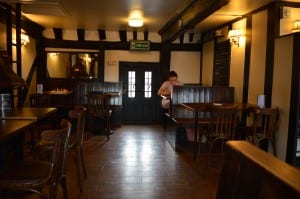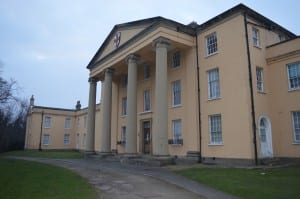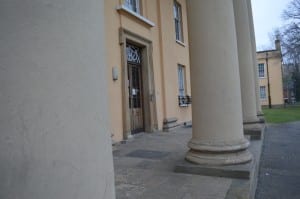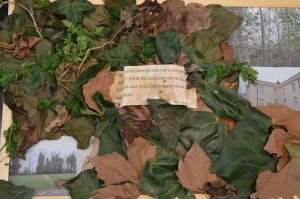The Madness Behind Coffee
The Madness Behind Coffee was our site specific piece performed at Stokes High Bridge café, 207 High Street, Lincoln. Performances started at 3:30 and went on until 5:15 with each performance being 10 minutes long. Audience had a minor role within the piece where they sit and take in what they are hearing and seeing. The performance was done to one person at a time; this was so that the audience could feel a one to one connection to the characters.
The Madness Behind Coffee is a piece that portrays the history and future of The Lawn Lincoln, of which has been taken over by Stokes coffee company. The portrayal was done using the themes of time, people, fact and fiction. The piece starts with the positive views of a doctor Edward Parker Charlesworth as he opens the Lawn as a Mental Asylum. The Nurse then takes over, portraying the negative aspects of working at the asylum. A patient at the Lawn gives a view from her perspective, being stuck inside for an unknown amount of time. After the patients story the audience are thrown forward in time to recent history, when Lincoln City Council was selling are the Lawn. Finally we heard from the Nigel Peirson the owner of Stokes Coffee company who has bought The Lawn.
The piece works using fact and fiction to create a story that will inform and entertain the audience. The background for the piece is based on information collected from the Lincoln City archives and sources within Stokes Coffee Company. Each characters dialogue had been created as a work of fiction with the basis and inspiration for the dialogue firmly based in fact. The piece was created in this manner to make the audience think about the history within their city and their country as mental asylums are found throughout the country. The future aspect of the performance was designed so that the audience would understand what is being done to the building, and how it can affect them as performers or as a part of their community.
The group was influenced by The Lawns unused state when we happened upon the building, and felt that the building had stories to tell the world. The original performance ideas where based around ghost stories conforming to the horror that could have occurred within the walls of The Lawn. The research process took shape by following these stories through the archives, from the words of the doctors and the lists of patients treated at the asylum. When moving into the present day we had to rely on the stories printed within the local papers and communications made with Nigel Peirson about his plans for the building. The performance moved into the coffee shop after construction work was due to start at The Lawn, making it impossible to perform at the location. The movement change the dynamic and ideas already planned out. This movement of location created the future aspect of The Lawn and the link to coffee.
Analysis of Progress
The piece The Madness Behind Coffee started as a piece about the fact and fictional hauntings of The Lawn. The influence behind the original idea came from the drift we took around the Lincoln. “Clearing eyes and peeling away the layers of spectacle, deception and that strange ‘hiddeness in plain sight’ that coats the everyday” (Mythogeography, 2015), being with a group helped us peel back our thoughts; and so we could start to express our ideas about the city around us.
The drift gave the opportunity to see The Lawn in a new light, we saw the modern rear exterior and where intrigued and wished to dig deeper. Digging deeper caused us to move around to the front of the building to discover its potential to a performance space (see Fig 1 and 2).
(Fig 1) (Fig 2)
The Lawn has a raised area around the columns, which becomes a natural stage from the perspective of a performer. The columns become a perfect area in which to hide and use to make the audience move to see what/who is there. Once we had discovered the building, we instantly saw its potential for horror and hauntings. At night the building produces an eerie feel to it, elevating the sense that it is haunted.
Our original idea saw us research deeper into the accounts of The Lawn being haunted. “There have been many reported sightings of ghostly figures, including those of children, roaming the corridors and grounds of the Lawn” (Haunted History of Lincolnshire, 2015). We played with the ideas recreating these stories and creating some of our own, as the audience where moved around the site. Upon further research into The Lawn as an Asylum we discovered that it was pioneering in the treatment of the mentally ill. The head doctor Dr Edward Parker Charlesworth was changing the treatment of the patient, “Dr Edward Parker Charlesworth pioneered new ways of treating mental illness, without the use of restraint and barbaric methods to control patients” (It’s About Lincoln, 2015). We saw this new information as an opportunity to show how the mentally ill where treated and when the change in treatment occurred. We were following the route of a horror story/tour because we wanted to entertain as well as informing the audience of the history behind The Lawn. The Lawn was very important as they went to great extents to help their patients, “The buildings stand in grounds of 8 acres which were deliberately planted with trees to shield the patients from “poisonous miasmas” which came from the industrialised parts of Lincoln.” (It’s About Lincoln, 2015). The planting of these trees showed how much care was taken to try to improve the standard of living for the people placed into Asylums. At this point, we thought that the horror story/tour would work best, as it would immerse the audience into the feelings that the patients would have felt, at their time at The Lawn and in other asylums of the time.
Fig 3
To better understand the inspirations behind our ideas we went to the Lincoln County Archives (see Fig 3). At the archives we spent time looking into patient records. Through these patient records, I discovered what the patients were being admitted for. The most common illnesses were Mania, Melancholic, Mania Hysteria and Dementia. This was interesting as it linked with a quote that was written in the catalogue of records available. Patients are to be treated, “With all the tenderness and indulgence compatible with the steady and effectual government of them and every occupation which may divert the mind, win at the tensions and awaken the affections be cheerfully and readily promoted”(Hospital Records BRO-RAU). A modified version of the quote remained in the final piece as it was a crucial part of the history of The Lawn in expressing how Lincoln was at the forefront of treating the mentally ill. The quote had to be edited because we felt it needed to be changed to flow with a modern audience, and to fit into the script that had been written around the quote.
The Doctors notes were also found in the archives. The Doctors notes gave us an insight into how the doctor treated, and thought about, the patients. The Doctor documents about Christopher Bonner, became one of the initial stories to be recorded.
“Christopher Bonner aged 25 was admitted on 4th (May 1824) He has [suffered] from his childhood, and just showed symptoms of insanity about a year since: this is his second attack. He has also congenital [diseases]. He is occasionally violent…’ (6th May 1824 J.M.)
‘Bonner has had several [attacks] of violence since his admission, he is very noisy today and is confined in a cell in a strait waistcoat.’ (9th May 1824 J.M.)
‘Bonner and Giston are dining in the adjoining room. The latter became violent yesterday and is confined with a chain around his waist and handcuffs attached to it. Bonner remains convalescent.’ (24th May 1824 J.M.)” (Marshall, 2015).
The story, even though important, was not used in the final cut of The Madness Behind Coffee because we could convey the information through other characters and formats. We also needed our male actors for other more import parts, as the site did not alow for easy or quick costume changes. The information from the Christopher Bonner recordings were placed within the menu and the speech made by the doctor at the beginning of The Madness Behind Coffee. We used a female patient’s story to portray the story of the patients within the asylum. Throughout the process the female patient stuck to our original idea of making the audience connect on an emotional level rather than giving the audience information like the other characters do. We wanted to make the audience connect with the patient, so that they could see what it might have been like to be mentally ill and stuck in an asylum.
We came to a stage where we discovered that we could not use The Lawn as our venue on the day of the performance. We could not use it as the new owners were planning to redevelop the site ahead of reopening in 2016. As we talked with the owners of the building, we discovered that we could use the grounds but with the possibility of construction interrupting the performance we decided to move the performance to a new site. The movement of site was to Stokes Coffee shop on Lincoln High Street (see Fig 4).
Fig 4  |
The coffee shop was chosen as it represented The Lawns future. The plans for the building are “The company will make The Lawn an operational outlet for Stokes Tea and Coffee, with a roastary, café, barista training and wholesale.” (Elizabeth Fish, 2014). These plans for The Lawns future, started to make me look at the pilgrimage the building has taken through the writing of Frederic Gros. Gros talks of how people go on pilgrimages to become better within themselves. “Internal transformation remains the pilgrim’s mystical ideal: he hopes to be absolutely altered on his return.”(Gros, 2014). The hopes for the owners of the building are for “internal transformation” (Gros, 2014) of the building as it takes a pilgrimage through time finding its purpose within the community. The buildings pilgrimage through time was represented in our piece using the different occupations it has held, and how Stokes is looking to the buildings future. The Lawn is also a part of other pilgrim’s journey, during its time as a mental asylum. The building was a shelter for the mentally ill, the pilgrims, as they passed through on their way to being healthy again or to see out their lives.
The purchasing of The Lawn gave us new material to work into the performance. We now wanted to include the thoughts of the new owners. We created a fictional speech made by Nigel Pearson about their plans for the buildings new developments and why. We included these factors into the speech as we felt it would give the audience a clear picture of how this will affect them as a community. We also wanted to include the information in another format, so that the audience would not be bombarded with information through the audio, and so the audio could be more of a narrative than informative.
We started to experiment with the formats that we would use to convey the information about the history of The Lawn. The first format to be worked on by the group was to use newspaper of the period as tool portray information. Ultimately, the newspapers were not used, as it was felt that it would be too much information to be read by the audience in the time that they had. The next idea to be experimented with was to use mood boards. The reasoning behind the mood boards was to give the audience a 3D texture to the information they were reading (see Fig 5).
|
Fig 5 |
The 3D texture was achieved though using leaves and sticks, from The Lawns grounds, to link with the site and provides the audience with a feel of being at the site. The use of the foliage from The Lawn reflected the traces left behind at the site and what occurred during the passing of time at the site on its pilgrimage through time.
After a rehearsal with the mood boards, we discovered that they were not suitable or practical for use within the performance. They were not suitable because they were too large for the tables we were using in the coffee shop and difficult to be used by the cast during the performance to move on and off ‘stage’.
The next the idea was to create a tablecloth in which to write the information upon, but we thought that the audience would not read all the information. This was when we decided that the information could be in a menu in a similar style to that of the coffee shop. We choose this format because it blended with the new site and gave us plenty of space to write the information upon. During the performance, we found that the audience enjoyed interacting with the menu and took it home with them after to read further into.
Performance Evaluation
For the final performances of The Madness Behind Coffee we had four audience members come to see the piece one at a time. The additional two audience members were another tutor interested in seeing this year groups productions, and a friend of the cast. Two of the audience members where our markers, who saw the performance last. We used the first audience members performances as dress rehearsal, to iron out any issues that we did not foresee during our rehearsals. The reactions from the all the audience members were positive and we used the time with our first members to discover their thoughts on the piece. It was mentioned that the first audience, member was not sure when to read the menu we had given her. The audience also noted that it is very ambiguous as to whether they could interact with the actors. Both of the previous points were solved by telling the audience that they could interact as much or little as desired, and directed towards the menu once sat down. We also found that the way we had blocked part of the piece where the action moves outside, was not clearly interpreted by the audience. Solving this lack of clarity was to have Ellie O’Sullivan to look out the window for a period to draw the audience member’s attention away from the room. A comment we received was that it felt branded towards the Stokes Coffee company, this was partly because of the site and the menu we used. The branding is something that we would have to alter if it were performed again.
The area that worked best was the patient’s scene, in which she set up a chessboard and played against the audience. During rehearsals, it had not been thought that the audience would try to play chess against the patient. As the patient and audience member started to play chess, it began to create a connection between the two that was not there before, as the patient did not have any physical connection like the other characters in the piece. The game of chess also brought the audience into the mind of the patient cutting them off from the rest of the world.
In hindsight, we would have liked to bring the Doctor, Nurse and Patient all together in one scene. Bringing these characters together would have drawn the threads together and given the audience an idea of how the staff and patients would interact with one another. The extra scene would have also delved deeper into the practices of The Lawn in comparison to the other mental hospitals.
If we were to perform the piece again, I would have liked to make it longer and more indepth to some of the characters from the past. There were also periods in The Lawns history that we only touched upon in the performance. These periods of history, I would like to create new characters to explore these through the communities’ feelings towards the building.
References
Bullock, L; Fitzgerald, A; Marshall, A; O’Sullivan, E; Robinson, S. (2015) The Madness Behind Coffee. [performance] Lincoln: Stokes Coffee Shop, 7 May.
Elizabeth Fish (2014) RW Stokes win bid to revamp The Lawn in Lincoln. [Online] Lincoln: Lincolnite. Available from thelincolnite.co.uk/2014/11/stokes-coffee-win-lincoln-lawn-bid/ [Accessed 13 May 2015]
Gros, F. (2014) A Philosophy of Walking. London: Verso.
Haunted History of Lincolnshire (2015) The Lawn [online] Lincoln. Available from: http://hauntedhistoryoflincolnshire.blogs.lincoln.ac.uk/lincoln/the-lawn/ [Accessed 11 May 2015]
Hospital Records BRO-RAU, (date unknown) The Lawn [Interim Draft Catalogue] Lincolnshire Archives. Lincoln.
It’s About Lincoln (2015)Lincoln Lunatic Asylum. [online] Available from http://www.itsaboutlincoln.co.uk/lincoln-lunatic-asylum.html [Accessed on 11 May 2015]
Marshall, A (2015) My City of Lincoln Story The Lawn – Lincoln Achieve – Alex Marshall. [Blog entry] 6 February. Lincoln: Available from sitespecific2015ksa.blogs.lincoln.ac.uk/author/13393935/ [Accessed 12 May 2015]
Mythogeography (2015) Starter Kit. [Online] Available from www.mythogeography.com/starter-kit.html [Accessed 11 May 2015]
Robinson, S. (2015) Fig 1 – The Lawn [photograph]
Robinson, S. (2015) Fig 2 – The Lawn [photograph]
Robinson, S. (2015) Fig 3 – The Achieve [photograph]
Robinson, S. (2015) Fig 4 – Inside Stokes Coffee Shop [photograph]
Robinson, S. (2015) Fig 5 – Mood Boards [photograph]



